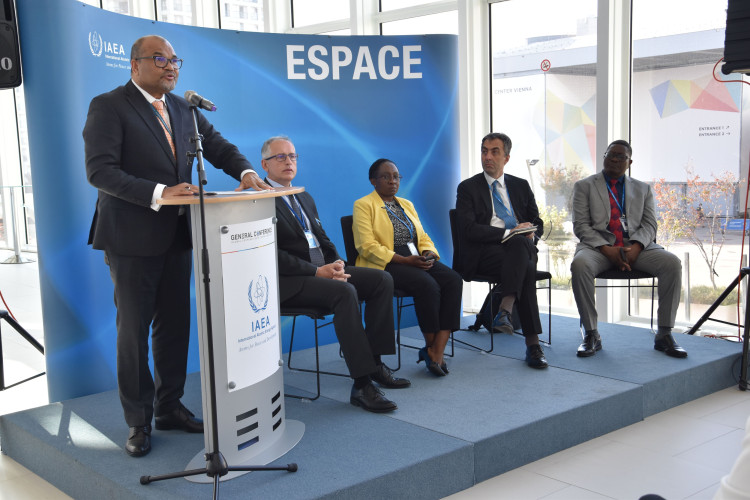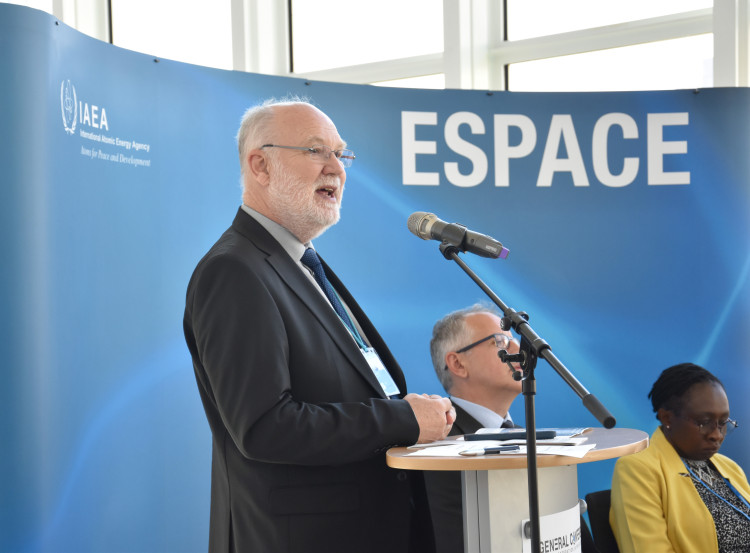According to the African Union Development Agency, the energy needs of the African continent are expected to more than triple by 2040. To help countries to address this growing demand for energy and meet socioeconomic needs in a clean, sustainable, and affordable way, the IAEA and International Renewable Energy Agency (IRENA) have been supporting, as official modelling partners, the development of the Continental Power System Masterplan (CMP) in Africa since 2021. In the margins of the IAEA's 67th General Conference, experts from different international organizations, including from the European Union who have been backing the initiative, shared the vision behind the CMP and discussed its key deliverables, which were adopted by the African Ministers of Infrastructure and Energy earlier in September and are due to be presented to the African Union assembly next year for final endorsement by African heads of state.
Power systems in Africa are organized into four subregions or 'power pools,' each of which faces different challenges based on available resources, infrastructure and needs. "These power pools are the building blocks of the future African Single Electricity Market (AfSEM), because by connecting neighbouring countries from different power pools, the end result will be a fully integrated electricity market," said Stephen Dihwa, Executive Director of the Southern Africa Power Pool. This process has already started by connecting the electricity grids of Tanzania and Zambia, Dihwa went on to explain, resulting in the integration of the East African and South African power pools from Cape Town to Cairo.
Going forwards, the CMP will act as the 'blueprint' for the AfSEM and act as a central pillar in solving Africa's energy challenges. "We are proud of this unique initiative, which is the result of a bottom up, collaborative approach involving representatives from the Regional Economic Communities, power pools, and energy stakeholders on the continent working together with international partners and organizations towards a common goal," said Towela Nyirenda-Jere, head of the African Union Economic Integration Division, speaking at the event. "It shows what can be achieved when we all work together to achieve the aspirations of the Agenda 2063 and Sustainable Development Goals," she added.
How will the CMP work?

Shaukat Abdulrazak, Director of the IAEA's Technical Cooperation Division for Africa, addressed members of the audience and the high-profile panellists from the IAEA, the African Union Development Agency, the European Union and the South African Power Pool. (Photo: J. O'Brien/IAEA)
The CMP will create a common and harmonized platform to support project decision making regarding the location, size and timing of investments in generation and transmission infrastructure. The priority generation and transmission projects that emerge from the CMP will make it possible for countries to take advantage of complementarities between national systems, with surpluses from some countries offsetting deficits in others, leveraging national and regional diversity in resources and demand.
Energy planning is key to understanding how to achieve cross-border power exchanges and inter-power pool trade. "An energy plan compares energy development scenarios using modelling tools such as MESSAGE and SPLAT, analysing all aspects of energy demand, production, conversion, transformation and distribution in order to reach conclusions on the most suitable long-term plan for energy production (which may include nuclear energy)," explained Mario Tot, Energy Systems Analyst from the IAEA.
Given the undeniable effect that climate change is already having on the continent, the CMP is an opportunity for Africa to compare different energy scenarios, pooling resources to invest in green and sustainable sources of energy from the word go to solve its growing energy challenges.
"Africa needs to take full advantage of its rich energy resources to achieve an affordable and sustainable clean energy transition," said Wei Huang, Director of the IAEA's Division of Planning, Information and Knowledge Management. "Proper and timely energy planning to support decision making is key to meeting the objectives in terms of energy sourcing, distribution and storage." The IAEA, in cooperation with other partners, has been supporting countries in Africa on building energy planning capacity and will continue to do so in their pathway towards a low carbon future.
The development of regional energy infrastructure is expected to catalyse the creation of large and competitive markets by reaping the benefits of economies of scale. The development of cross-border energy infrastructure will culminate in the development of a fully integrated continental electricity market that will enhance trade and increase access to electricity for Africa's 600 million people without connections to the power grid. It will enhance the socioeconomic development of the African continent by providing low cost and carbon-free energy for agriculture, industry, communications and trade under the Agreement Establishing the African Continental Free Trade Area (AfCFTA).
Together with IRENA and other international organizations, the IAEA has actively supported the development of the CMP since 2021 by sharing training, expertise and resources with regard to energy planning and modelling.
"Our contribution to the development of Africa's Continental Master Plan is a great milestone," shared Shaukat Abdulrazak, Director of the IAEA's Technical Cooperation Division for Africa. "There is a pressing need for clean, dependable energy to fuel further socioeconomic growth in the continent, and the IAEA stands by to support it," he added.
Following the presentation of key points by each speaker, a lively discussion between panelists and the audience ensued. Attended by more than 30 people, the event was a demonstration of what can be achieved when governments, international organizations and other key stakeholders come together to solve pressing regional issues.

Neil Jarvis, Section Head of the IAEA's Technical Division for Africa, introduced the speakers and moderated the successful event. (Photo: J. O'Brien/IAEA)






